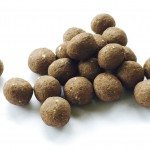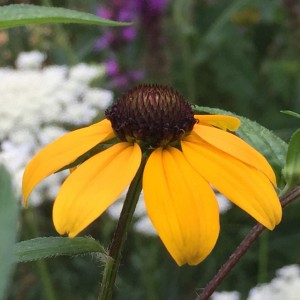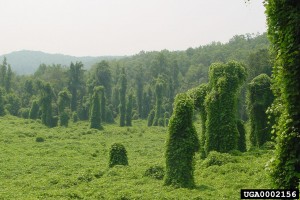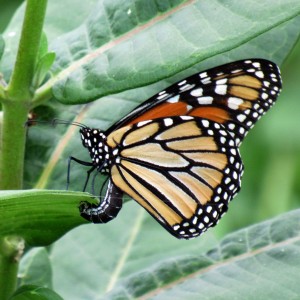Gardening with wildflower seed balls can be fun, simple, and rewarding, but it does require some planning. Planning requires some knowledge. Here are some wildflower basics and how we use seed balls to work synchronously with each wildflower species’ particularities.
Shop for wildflower seed balls
View a gallery of suitable wildflower seed ball species.
Reproductive Strategies
Wildflowers have different strategies for reproduction, and how you use your seed balls should work with the particular reproductive strategies of the plant rather than at odds. Some species, like Rudbeckia hirta, and Rudbeckia triloba, produce a wild abundance of tiny seed, with the chance that some will germinate. Others, like the might oak and the nut trees, invest a lot of resources in each seed, producing fewer seeds, but each one is equipped with energy reserves and a shell better for survival.
In addition to the biomass and characteristics of the seed coat, many wildflower seeds are very particular about when and where they are planted. Many require seeding in the fall. The seeds will not grow at all unless they have cycled through a winter- some require several winters and certain sequences of freeze/thaw and moisture cycles to germinate!
These requirements serve two purposes, to ensure that the seeds don’t germinate right before winter. The tender seedlings would freeze. In some cases, this germination ‘lock’ may prevent the seed from sprouting before a dry season or some other fatal stressor.
Seed Ball Techniques
- Some large seeds just don’t need a seed ball! If guerrilla gardening oaks, for example, just press whole acorns into moist soil.
- Read about the germination requirements of the seed. Think about how a seed ball can support those requirements. Seed depth, water, temperature, and seasonality are among the critical factors influencing seedling germination.
- Place tiny or light-sensitive seeds on the surface of the seed ball. These seeds are generally produced in abundance and may have relatively low native viability. Use MORE of the tiny seeds.
- Place seeds that animals will love to forage (legumes, sunflowers, etc.) inside the seed ball where they will not be sniffed out so easily!
- Sow small-seeded wildflower seed balls on the surface, and make those seed balls smaller, closely mimicking the plant’s evolved reproductive strategy.
- Plant seeds and seed balls at the right time of year. If unsure, plant near the time the species usually goes to seed. Harvest wildflower seed. Make wildflower seed balls. Sow wildflower seed balls. All within a few weeks.
Germination Rate & Seed Bank Lifespan
Another method that wildflowers use to ensure reproductive stress is have a highly variable germination rate. This way, if seeds germinate and there is a late freeze, or a dry spell and that batch withers, there will be more viable seed in the ‘seed bank’ of the soil. A great strategy, this can be very frustrating for gardeners who want wildflowers and want them NOW! This is also why weeds seem to keep coming up even when you remove them. Weeds, like bindweed and kudzu, have seeds that can lay dormant, deep in the soil for many many years. Plants with these strategies can be very hard to eradicate.
Seed Ball Techniques
- Look up the germination rate, viability and time for the wildflower you’ll be growing in your seed balls.
- If the seeds have highly variable rates, and low viability, add more seeds to each seed ball.
- If you can, be patient with wildflower seeds. Years of patience for some species! If you have used good quality seed, it will come up when conditions are right after the proper cycle of seasons has passed.
- Plant species that are native to your area. This will ensure that the conditions for germination are likely to occur.
- Add some faster-blooming species to your mix. This will add cheer while you are waiting for those prairie show-stoppers to mature! Try these: Clarkia, California Poppies, Yarrow, Flax, and Bee Balms.
- Consider planting some vegetables in your garden in the spring, then plant the perennials in the fall.
Photograph of Kudzu by Kerry Britton, USDA Forest Service, Bugwood.org.
Roots
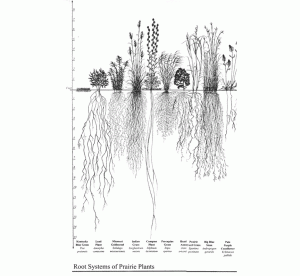
The root systems of various native species, compared to the tiny roots of the typical lawn, far left.
Lastly, perennial wildflowers have one additional ace in the hole- they exist mostly underground. All those bright, cheerful, and unusual blossoms are only a small portion of the plant. Some wildflowers have roots almost 15-feet below the surface, like the Compass Plant! Most have a complex architecture of roots that is 3′- 5′ deep, quite wide, and brilliant at sucking water out of seasonally dry soils and surviving periodic drought. These roots are critical for the plants’ survival, and so the first priority of the seed is not to produce flowers, it is to produce roots. Boring… no purple, no pink, no harvest gold, and no pollinators sometimes for as many as 3 or 4 years with some species. Happily, there are many exceptions for the impatient gardener, but most perennial wildflowers won’t bloom until year 2 or 3.
Seed Ball Techniques
- Include some short-lived annual wildflowers that will your seed ball mix! As with, above, Clarkia, California Poppies, Yarrow, Flax, and Bee Balms are some great choices.
- Pick up a couple mature plants from a native plant nursery in your area. Begin your garden with these, and supplement with seed balls.
- Plant host plants like milkweed and lupine. Butterflies lay eggs on the leaves of these plants most typically, and don’t hesitate to do so! They won’t notice that it isn’t flowering yet!
- Be patient. Observe the quality of the foliage, and think of those strong roots reaching deep into the earth.





